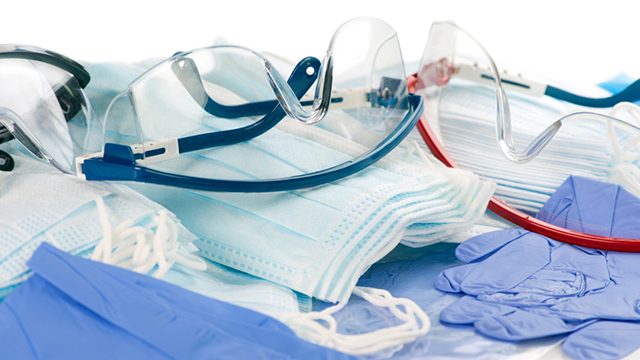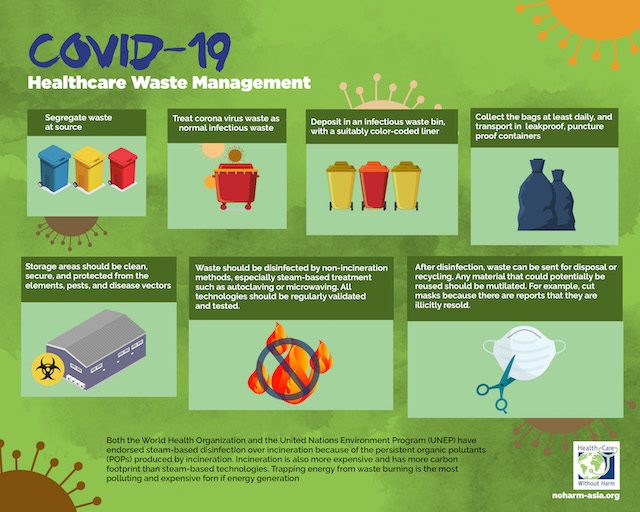SUMMARY
This is AI generated summarization, which may have errors. For context, always refer to the full article.



In our continuing effort to support all initiatives to address the challenges that COVID-19 is imposing upon us, Health Care Without Harm Southeast Asia would like to share with our health sector partners, allies, as well as frontline health communities the following recommendations on managing COVID19-related waste such as masks and PPEs.
It is with deep gratitude and profound respect to our frontline health workers that we are sharing these timely recommendations in order to ensure that the noble work they are doing at the front lines is not impeded and breached, and thus made worse. (READ: IN NUMBERS: What hospitals need to treat COVID-19 patients)
As COVID-19 is a new virus, it should be pointed out that there is no established waste treatment process yet for waste generated in response to it. Nonetheless, according to the WHO, any health facility exercising best practices for infectious waste will also be able to manage waste potentially infected with COVID-19. Yet, special attention may still be given to COVID19-related waste such as PPEs by setting up a distinct bin for these types of waste, which then gets double bagged for safe transport. Segregating waste at the source should always be observed.
There is no need to incinerate COVID19-related waste since medical waste autoclaves that use pressurized steam at 30psi at a saturation time of 30 minutes are known to kill any heat-resistant pathogens without need for chemicals whatsoever. A temperature up to 135°C degrees or higher achieves microbial inactivation at a 99.9% kill rate on the most heat-resistant pathogens known to science, including Baccillus Stearothermophilus.
Once disinfected in an autoclave, COVID19-related waste, like any other hospital solid waste that underwent autoclaving, can then be treated as regular municipal waste. All technologies, whether autoclave or microwave should be validated and regularly tested.

(Incinerators as well as incinerators-in-disguise like pyroclaves, gasification, pyrolysis, and plasma arcs, apart from being overly expensive, produce deadly dioxins and furans that further harm people’s health instead of protecting it.)
Any PPE that could potentially be reused should be cut to pieces. Cut masks, for example, because there are reports that they are being illicitly resold. Thus, advise every staff to do this to PPEs they individually use before discarding them into appropriate bins.
Because the COVID-19 virus survives briefly in tropical temperatures, as an additional safety measure, it is recommended to label every bag of PPE waste with their collection dates and have them stored in waste holding areas for at least 3 days to ensure that no virus survives in the collected items. See to it that they are in leak-proof, puncture-proof containers, and that storage areas are clean, secure, and protected from the elements, pests, and disease vectors. (READ: ‘Chronic’ global shortage of virus protective gear ‘urgent threat’ – WHO)
Finally, we can never overemphasize the importance of proper hand washing, especially for hospital personnel handling wastes. Together with appropriate PPEs, washing hands make a formidable defense against the virus. Since we know that the coronavirus that causes COVID-19 is coated in lipids that dissolve in soap, which then result in the complete destruction of the virus, washing hands properly with soap and water remains to be the simplest and most consistent way of preventing the spread of or getting infected by the virus. – Rappler.com
Dr. Esperanza Cabral is the President of Health Care Without Harm Southeast Asia’s Board. She served as Secretary of the Department of Health in the Philippines. Before her appointment as Secretary of Health, she was previously the Secretary of the Department of Social Welfare and Development.
Paeng Lopez is Health Care Without Harm Southeast Asia’s Healthy Energy Initiative Campaign Coordinator. He has been in the environmental movement for 25 years, and has worked as youth convenor, community organizer, project coordinator, and researcher for various conservation organizations.
Add a comment
How does this make you feel?
There are no comments yet. Add your comment to start the conversation.